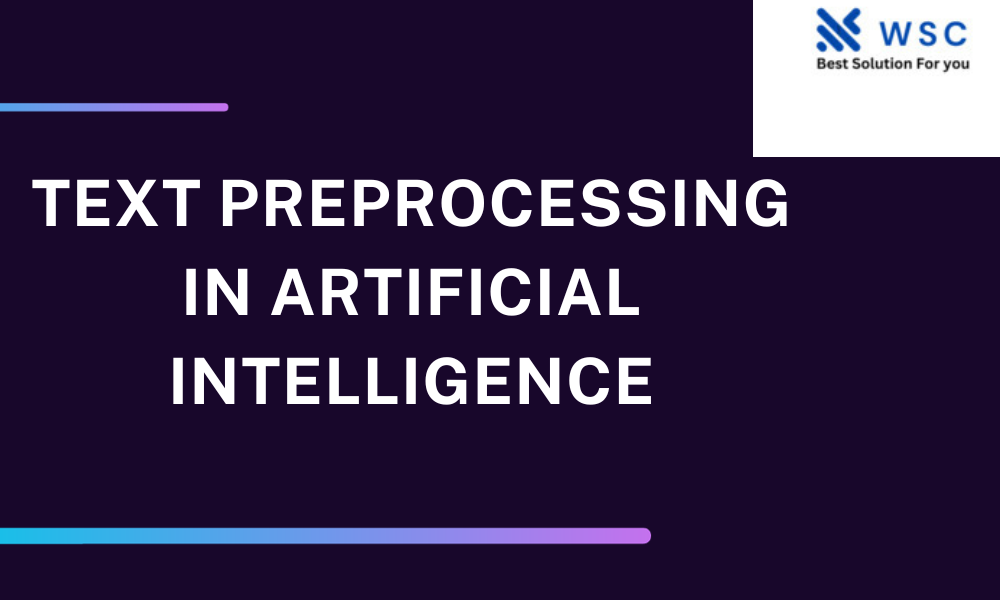In the ever-evolving landscape of technology and data-driven decision-making, Artificial Intelligence (AI) has emerged as a game-changer. AI’s ability to analyze massive datasets and extract meaningful insights has revolutionized various industries, from healthcare to finance and beyond. At the heart of AI’s capabilities lies Pre Processing of Text Data in Machine Learning, a fundamental process that prepares textual data for analysis and modeling. In this comprehensive guide, we will delve deep into the world of text preprocessing in AI, uncovering its importance, techniques, and its crucial role in empowering AI models to deliver accurate and insightful results.
Understanding Text Preprocessing
Text preprocessing is the vital first step in any natural language processing (NLP) or machine learning project involving textual data. It involves a series of techniques and transformations applied to raw text data to make it suitable for analysis and modeling. The primary objective of text preprocessing is to clean and structure the text so that AI algorithms can efficiently extract meaningful information from it.
The Importance of Text Preprocessing in AI
1. Noise Reduction
Raw textual data often contains noise in the form of punctuation, special characters, and irrelevant symbols. Text preprocessing techniques such as removing stopwords, punctuation, and special characters help in reducing this noise, making the data more suitable for analysis.
2. Tokenization
Tokenization is the process of breaking text into individual words or tokens. It’s a crucial step in text preprocessing as it allows AI models to understand the structure of the text and analyze it at a granular level.
3. Lowercasing
Uniform casing of text (usually converting all text to lowercase) ensures that the AI model treats words with different cases as the same entity. This prevents redundancy and improves the model’s efficiency.
4. Lemmatization and Stemming
Lemmatization and stemming are techniques used to reduce words to their base or root form. This is essential for text preprocessing as it reduces the dimensionality of the data, making it easier for AI models to process.
5. Removing HTML Tags and URLs
In text data sourced from websites or social media, HTML tags and URLs can be distracting and irrelevant. Removing them during preprocessing enhances the quality of the data.
Techniques in Text Preprocessing
Now, let’s explore some of the key techniques in text preprocessing that are pivotal for the success of AI models:
1. Stopword Removal
Stopwords are common words such as “the,” “and,” “in,” etc., that don’t carry significant meaning. Removing them helps focus the analysis on meaningful content.
2. Spell Checking and Correction
Correcting spelling errors ensures that the text data is accurate and that AI models won’t misinterpret misspelled words.
3. Part-of-Speech Tagging
Identifying the part of speech of each word in a sentence can aid in sentiment analysis and understanding the context of the text.
4. Named Entity Recognition (NER)
NER is crucial for identifying and classifying entities like names of people, organizations, locations, and more within the text.
5. Text Normalization
Normalization techniques like transforming abbreviations to full words and standardizing dates and numbers ensure consistency in the data.
The Role of Text Preprocessing in AI Models
Now that we’ve covered the importance and techniques of text preprocessing, let’s discuss how it directly impacts the performance of AI models.
1. Improved Accuracy
Clean and well-preprocessed text data leads to more accurate AI models. By reducing noise and standardizing the text, models can focus on relevant patterns and relationships.
2. Enhanced Generalization
Text preprocessing helps AI models generalize better to unseen data. It enables models to extract features and information effectively, making them more adaptable to new textual inputs.
3. Faster Training
Efficiently preprocessed data accelerates the training process of AI models, allowing organizations to develop and deploy AI solutions faster.
Certainly, if you’re looking for some practice code related to text preprocessing in the context of the article we just discussed, here’s a Python code snippet using the NLTK library for some common text preprocessing tasks:
# Import the necessary libraries
import nltk
from nltk.corpus import stopwords
from nltk.tokenize import word_tokenize
from nltk.stem import WordNetLemmatizer
import re
# Sample text data
text = "Text preprocessing is crucial for NLP. It helps in cleaning and structuring textual data."
# Tokenization
tokens = word_tokenize(text)
# Removing punctuation and converting to lowercase
cleaned_tokens = [word.lower() for word in tokens if word.isalpha()]
# Removing stopwords
stop_words = set(stopwords.words('english'))
filtered_tokens = [word for word in cleaned_tokens if word not in stop_words]
# Lemmatization
lemmatizer = WordNetLemmatizer()
lemmatized_tokens = [lemmatizer.lemmatize(word) for word in filtered_tokens]
# Joining the tokens back into a processed text
processed_text = ' '.join(lemmatized_tokens)
# Removing special characters and numbers
processed_text = re.sub(r'[^a-zA-Z]', ' ', processed_text)
# Print the processed text
print(processed_text)
Conclusion
In the realm of Artificial Intelligence, text preprocessing serves as the foundation upon which accurate and insightful models are built. By cleaning, structuring, and enhancing textual data, text preprocessing empowers AI models to deliver results that drive informed decision-making across various industries.
As you embark on your journey into the world of AI and NLP, remember that the quality of your text preprocessing can make all the difference. Embrace the techniques mentioned here, and you’ll be well on your way to mastering the art of text preprocessing in Artificial Intelligence.
Check our tools website Word count
Check our tools website check More tutorial




